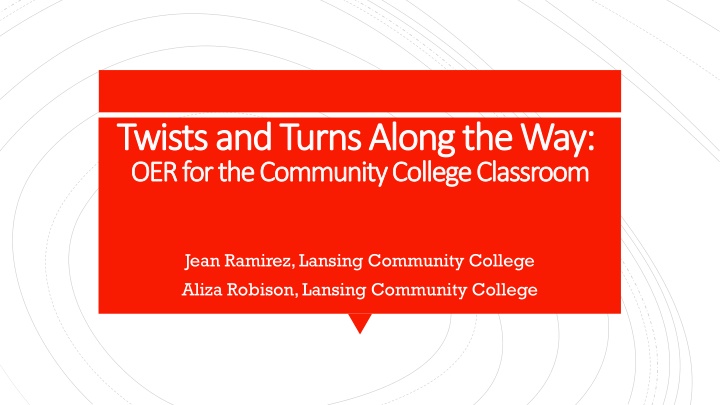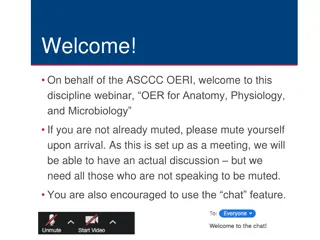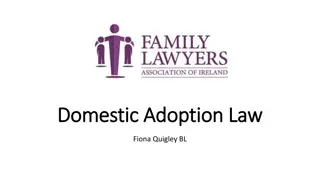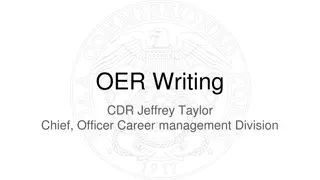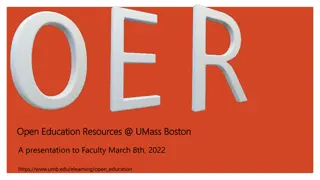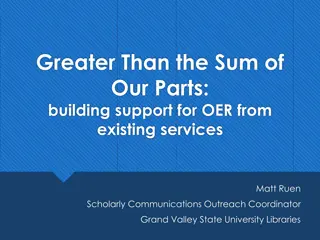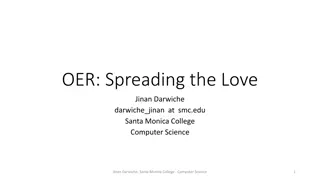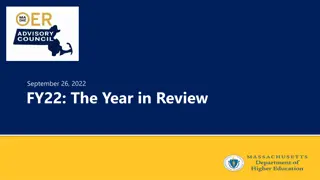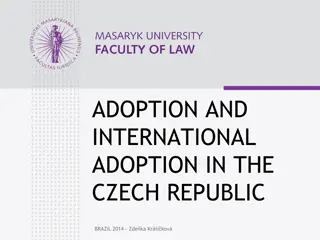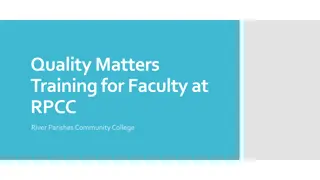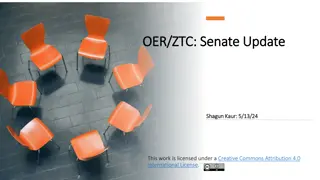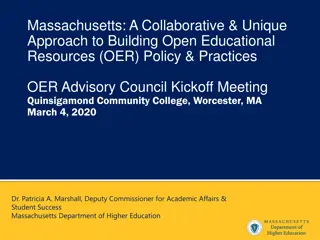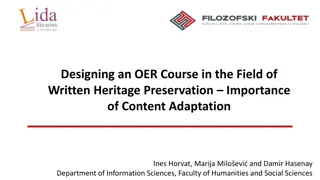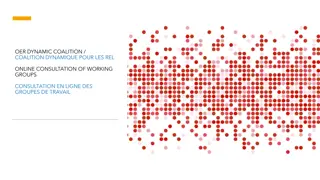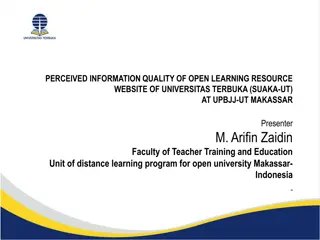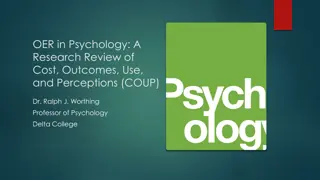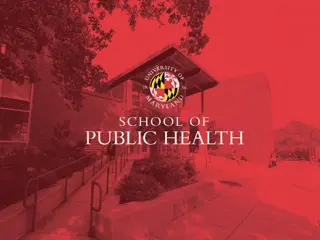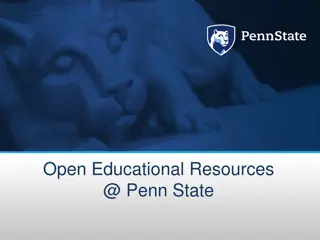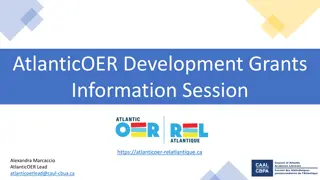OER Adoption Journey at Community College
The transition to Open Educational Resources (OER) at a community college, this case study follows the journey from textbook affordability challenges to faculty grant proposals, team collaborations, content revisions, and pilot group feedback for OER adoption. The timeline showcases the steps taken in OER development and implementation, highlighting the impact on student textbook purchasing habits and future course registration preferences."
Download Presentation

Please find below an Image/Link to download the presentation.
The content on the website is provided AS IS for your information and personal use only. It may not be sold, licensed, or shared on other websites without obtaining consent from the author.If you encounter any issues during the download, it is possible that the publisher has removed the file from their server.
You are allowed to download the files provided on this website for personal or commercial use, subject to the condition that they are used lawfully. All files are the property of their respective owners.
The content on the website is provided AS IS for your information and personal use only. It may not be sold, licensed, or shared on other websites without obtaining consent from the author.
E N D
Presentation Transcript
Twists and Turns Along the Way: Twists and Turns Along the Way: OER for the Community College Classroom OER for the Community College Classroom Jean Ramirez, Lansing Community College Aliza Robison, Lansing Community College
Approximately 80 sections and 2400 students annually Textbook $190 per new book, totaling $475,000 OER Educational equity issue presented due to affordability RATIONALE
In general, how often do you purchase the required textbooks for the courses you take? 11.9% Never STUDENT SURVEY (2018-19) 31.7% Rarely 15.4% Half the time Often Always 18.8% 22.2%
How likely are you to register for a future course that uses an OER like the one used in this course? 53.5% VERY LIKELY STUDENT SURVEY (2018-19) 35.9% SOMEWHAT LIKELY 5.3% SOMEWHAT UNLIKELY 5.2% VERY UNLIKELY 0.0% 10.0% 20.0% 30.0% 40.0% 50.0% 60.0%
Spring 2017 program faculty examined and rejected available OER options and put OER adoption on hold Fall 2017 faculty member found existing OER that needed revision and remixing, but had potential Sociology: Understanding & Changing the Social World PRE-OER TIMELINE Fall 2017 faculty member proposed OER development, and recruited other faculty to OER team Fall 2017 faculty member wrote grant to support revision-remix of pre-existing OER
Spring 2018 Grant received followed by formal training OER Team meetings began Outreach to pilot faculty (65% commitment) OER Spring - Summer 2018 Revised and remixed text (2-3 chapters per person) Developed textbook ancillaries 2nd edit for accuracy and consistency in formatting Develop D2L site to house OER Electronic distribution to pilot group TIMELINE
Fall 2018 Pilot group use of text and ancillaries Feedback elicited from faculty and students 3rd edit of some chapters and ancillaries Spring 2019 70% adoption by faculty 4th edit to make text accessible Feedback elicited from faculty and students OER TIMELINE Summer 2019 5th edit for publication at lulu.com Fall 2019 100% adoption (non-mandatory)
Goal to find a comprehensive text that could remixed into a foundational text in order to simplify and focus on the core material, to which faculty could add based on their interests or areas of expertise. TEXT Text needed to not only include foundational theoretical perspectives, theories and concepts, but also include adequate data in order to promote quantitative literacy. SELECTION CRITERIA Text needed to be approachable and engaging enough for students who have different reading levels and interests (appropriate reading level) and to be written with a cohesive voice (single author).
Faculty participants recruited by grant writing faculty based on the following criteria: Years of experience teaching SOCL120 Content expertise in a variety of areas Theoretically oriented in various ways Pedagogical innovation OER TEAM Collaborative structure with team leaders: One leader provided organizational and editing leadership One leader provide technical expertise
Determined organizational structure, including: General content areas Number of chapters Key learning outcomes Range for maximum chapter length Ancillaries DECISIONS Controversies that arose: Should a chapter on social change be included? Should the OER textbook be traditionally structured? Should the integrity of original text be maintained?
Distributed chapters to team for remixing and revision, and established deadlines for work Each team member responsible for remixing-revising and developing ancillaries for 2-3 chapters Work done independently within a 3-month timeframe Some OER chapters combined two chapters from comprehensive original text Revision necessitated update of 10-12 year old data DECISIONS
Graduated steps taken to adopt OER Voluntary fall 2018 pilot by 65% of faculty/classes 3rdedit to revise data in numerous chapters and remix two chapters that were not completed Voluntary spring 2019 adoption by 70% of faculty/classes 4thedit to incorporate fall feedback from pilot group and to make text accessible 5thEdit in Summer 2019 for publication OER ADOPTION Added title, cover, preface, table of contents, glossary and reference appendix, updated photos/graphics Ancillaries edited for accessibility Voluntary fall 2019 adoption by 100% of faculty/classes Summer & fall 2019 new comprehensive final exam created to align with OER
Plans for continued curation of OER text 2019-20 academic year, let it rest Solicit feedback from faculty and students 2020-21 release time, summer pay or grant to update OER 2-year cycle for revisions thereafter FUTURE CURATION
Disagreement on the extent of revision-remix and key learning outcomes TWISTS AND TURNS Combining chapters from the original text required strong editorial skills Updating data required strong research skills Timeframe for original revision/remix too short for some team members, with missed deadlines & incomplete edits Several team members did not update data, requiring team leader to complete 3rdedit during pilot phase Pilot faculty meeting unwieldy & not fruitful College accessibility initiative compounded work Team too big, making quality control a challenge
Daily 2-3 x per week 2-3 x per month 2-3 x per semester Never 35.80% 34.5% 24.70% 23.9% 23.0% STUDENT SURVEY (2018-19) 16.50% 11.70% 11.40% 11.9% 6.8% HOW OFTEN REQUIRED TEXT USED HOW OFTEN OER USED
Smaller team (3-4 maximum) Work in pairs for 1st revision Longer timeframe for 1st revision Round-robin 2nd edit prior to adoption Recruit designated reader to critically review text once 2nd edit is complete SUGGESTIONS Include tech savvy team member During editing phase, check for stylistic similarity Include an intentional review by students Faculty feedback via chapter specific survey Strategize on methods to ensure that students read text
Jean Ramirez lynchbj@star.lcc.edu THANK YOU Aliza Robison chalge@star.lcc.edu
